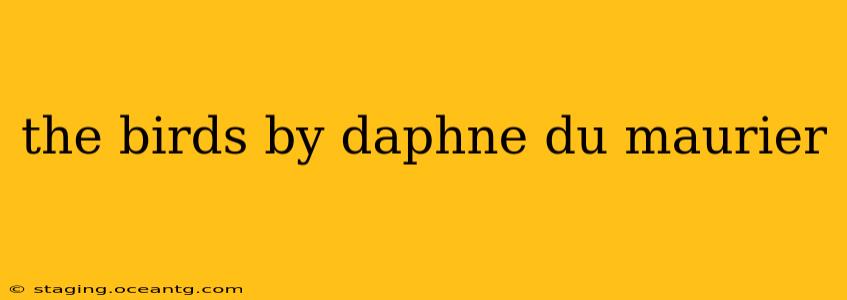Daphne du Maurier's The Birds, a chilling novella published in 1952, transcends its short length to become a potent exploration of nature's unpredictable power and the fragility of human existence. Far from a mere bird-attack story, it’s a psychological thriller subtly building dread and unease, leaving a lasting impression long after the final page is turned. This exploration delves into the story's themes, its enduring impact, and answers some frequently asked questions.
What is the story of Daphne du Maurier's The Birds?
The story unfolds in a seemingly idyllic English coastal village, where a series of increasingly violent bird attacks begin to terrorize the inhabitants. Initially, it's just a few pecks and minor skirmishes, easily dismissed. However, the attacks escalate dramatically, with larger flocks of birds – predominantly crows, gulls, and starlings – exhibiting bizarre and aggressive behaviour, coordinated in their assault on humans and their homes. Nat Hocken, the protagonist, witnesses the escalating horror firsthand, documenting the escalating chaos and the community’s desperate struggle for survival as civilization crumbles under the weight of feathered fury. The narrative focuses on the growing fear and uncertainty, culminating in a terrifying climax that leaves the reader pondering the unsettling ambiguity of the ending. Du Maurier masterfully employs suspense, creating an atmosphere of mounting dread and leaving the underlying cause of the avian onslaught a mystery.
What is the meaning/symbolism behind the birds in The Birds?
The birds in The Birds are more than just feathered antagonists; they are potent symbols. Their sudden, inexplicable aggression can be interpreted in various ways:
-
Nature's Unpredictable Power: The birds represent the untamed forces of nature, reminding us of our vulnerability in the face of the natural world. Their attacks are random and merciless, highlighting the fragility of human civilization when confronted by seemingly uncontrollable forces.
-
Primal Fear: The birds tap into our primal fears – fears of the unknown, of being overwhelmed, and of losing control. The relentless attacks strip away the veneer of civilization, revealing humanity's raw vulnerability.
-
Loss of Order & Control: The birds' coordinated attacks disrupt the established order of society, mirroring the anxieties of the post-war era. The breakdown of order and society's inability to control the situation are chilling parallels to real-world anxieties.
-
Psychological Horror: The story also explores the psychological impact of the attacks, highlighting the characters' growing fear, paranoia, and eventual descent into madness. The ambiguous ending leaves room for interpreting the birds' aggression as a reflection of the characters' internal struggles.
What inspired Daphne du Maurier to write The Birds?
While the exact inspiration for The Birds remains a matter of speculation, it's widely believed that du Maurier's own experiences and observations played a crucial role. She lived in rural Cornwall, a region known for its dramatic coastline and diverse birdlife. It's likely that local folklore and anecdotal accounts of unusual bird behaviour, combined with her keen understanding of psychological suspense, contributed to the creation of this unsettling tale. The ambiguity surrounding the cause of the birds' rage leaves the reader to ponder its possible origins, making the story's impact all the more profound.
Is there a sequel to The Birds?
No, there is no official sequel to Daphne du Maurier's The Birds. Alfred Hitchcock's famous film adaptation, while inspired by the novella, diverges significantly in its plot and ending.
How does The Birds compare to Hitchcock's film adaptation?
Hitchcock's 1963 film adaptation of The Birds is significantly different from du Maurier's novella. While the basic premise remains the same – the sudden, violent attacks of birds on a coastal community – Hitchcock expands the story, adding characters and subplots. The film emphasizes the visual spectacle of the bird attacks, creating a more overtly horrific experience. However, it also provides a more defined narrative structure than the novella, with a slightly clearer sense of resolution, unlike du Maurier's deliberately ambiguous conclusion.
What is the ending of The Birds?
The ambiguous ending of The Birds is a key element of its unsettling power. The narrative concludes with Nat Hocken and his family trapped and surrounded by relentless birds, leaving their fate uncertain. This open-ended conclusion allows readers to contemplate the extent of the avian onslaught's impact, fostering a lingering sense of unease and emphasizing humanity's vulnerability in the face of the unknown.
In conclusion, The Birds is more than just a suspenseful story; it's a timeless exploration of primal fears, the unpredictable power of nature, and the fragility of human control. Its enduring appeal lies in its evocative atmosphere, its subtle psychological insights, and its chillingly ambiguous ending that continues to provoke discussion and interpretation decades after its publication.
